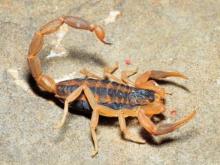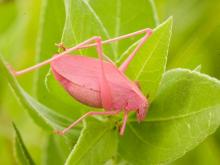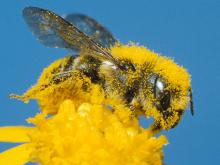Land Invertebrates
Media

Species Types
Scientific Name
Pisaurina spp.
Description
Nursery web spiders build silken tents in plants to protect their egg sacs, then stand guard until the hatchlings are ready to disperse. Large and velvety, nursery web spiders have long legs and variable color patterns.
Media

Species Types
Scientific Name
About 6,500 species have been named so far, worldwide.
Description
Daddy longlegs, or harvestmen, are familiar Missouri animals. They are not spiders, but opilionids. Unlike spiders, they have a fused body form and lack silk and venom glands.
Media

Species Types
Scientific Name
Neriene radiata (formerly Prolinyphia marginata)
Description
The filmy dome spider is one of the most abundant woodland spiders in Missouri. Although the spider is tiny, its snare web, which looks like an upside-down silk bowl, is conspicuous throughout the year.
Media

Species Types
Scientific Name
Centruroides vittatus
Description
Striped bark scorpions are pale yellowish brown, usually with two lengthwise dark stripes on the abdomen. It is the only species of scorpion in Missouri. It occurs in glades and other dry, warm, rocky areas, and sometimes in buildings and shelters and under piles of wood, brush, or garbage.
Media

Species Types
Scientific Name
Panorpa spp.
Description
Male scorpionflies will make you look twice, because the abdomen is tipped with what looks like a scorpion stinger! These nifty insects cannot sting, however.
Media

Species Types
Scientific Name
8 tribes, with about 23 genera, in North America north of Mexico
Description
Millipedes in family Xystodesmidae often have bright colors that serve as a warning to potential predators that they may secrete foul or toxic substances.
Media

Species Types
Scientific Name
Amblycorypha oblongifolia
Description
The oblong-winged katydid is one of many species in the katydid family. Although it is usually green in most places, some populations made up of pink-form individuals.
Media

Species Types
Scientific Name
More than 630 species in North America north of Mexico
Description
Megachilid bees are a family of solitary, native bees that carry pollen only on the underside of the abdomen, never on the hind legs. Large cutting mouthparts allow them to collect pieces of leaves, soil, or plant resins to line their nests.
Media

Species Types
Scientific Name
More than 1,200 species in North America north of Mexico
Description
Andrenid bees, also called mining bees, are solitary ground-nesters. Most are specialist pollinators whose life cycle is timed to correspond precisely to the blooming of specific flowers.
Media

Species Types
Scientific Name
Ommatius spp.
Description
Ommatius robber flies are medium-sized robber flies with distinctively branching antennae. There are about four of five species that might occur in Missouri.
See Also



Media

Species Types
Scientific Name
Cisseps fulvicollis
Description
The yellow-collared scape moth is more often “orange-collared.” And whether you think it looks more like a firefly or a wasp, it’s still a moth!
Media

Species Types
Scientific Name
Nearly 150 species in North America north of Mexico
Description
Slim, delicate plume moths are instantly recognizable by their T-shaped silhouette, long legs, and muted shades of tan and brown. It can be hard to separate the various species.
Media

Species Types
Scientific Name
Pyrrharctia isabella
Description
Not many people know the adult Isabella tiger moth when they see one, but we’re all acquainted with its caterpillar, the woolly worm, or woolly bear.
About Land Invertebrates in Missouri
Invertebrates are animals without backbones, including earthworms, slugs, snails, and arthropods. Arthropods—invertebrates with “jointed legs” — are a group of invertebrates that includes crayfish, shrimp, millipedes, centipedes, mites, spiders, and insects. There may be as many as 10 million species of insects alive on earth today, and they probably constitute more than 90 percent all animal species.





















